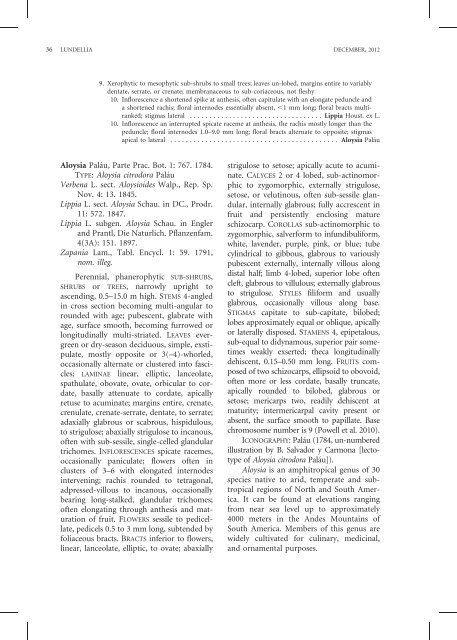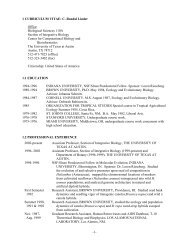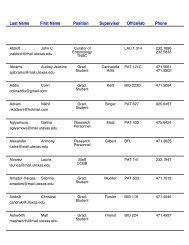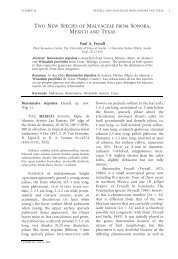FOUR NEW SPECIES OF THE GENUS ALOYSIA (VERBENACEAE)
FOUR NEW SPECIES OF THE GENUS ALOYSIA (VERBENACEAE)
FOUR NEW SPECIES OF THE GENUS ALOYSIA (VERBENACEAE)
Create successful ePaper yourself
Turn your PDF publications into a flip-book with our unique Google optimized e-Paper software.
36 LUNDELLIA DECEMBER, 2012<br />
9. Xerophytic to mesophytic sub-shrubs to small trees; leaves un-lobed, margins entire to variably<br />
dentate, serrate, or crenate; membranaceous to sub-coriaceous, not fleshy<br />
10. Inflorescence a shortened spike at anthesis, often capitulate with an elongate peduncle and<br />
a shortened rachis; floral internodes essentially absent, ,1 mm long; floral bracts multiranked;<br />
stigmas lateral . . . . . . . . . . . . . . . . . . . . . . . . . . . . . . . . . . Lippia Houst. ex L.<br />
10. Inflorescence an interrupted spicate raceme at anthesis, the rachis mostly longer than the<br />
peduncle; floral internodes 1.0–9.0 mm long; floral bracts alternate to opposite; stigmas<br />
apical to lateral . . . . . . . . . . . . . . . . . . . . . . . . . . . . . . . . . . . . . . . . . . . Aloysia Paláu<br />
Aloysia Paláu, Parte Prac. Bot. 1: 767. 1784.<br />
TYPE: Aloysia citrodora Paláu<br />
Verbena L. sect. Aloysioides Walp., Rep. Sp.<br />
Nov. 4: 13. 1845.<br />
Lippia L. sect. Aloysia Schau. in DC., Prodr.<br />
11: 572. 1847.<br />
Lippia L. subgen. Aloysia Schau. in Engler<br />
and Prantl, Die Naturlich. Pflanzenfam.<br />
4(3A): 151. 1897.<br />
Zapania Lam., Tabl. Encycl. 1: 59. 1791,<br />
nom. illeg.<br />
Perennial, phanerophytic SUB-SHRUBS,<br />
SHRUBS or TREES, narrowly upright to<br />
ascending, 0.5–15.0 m high. STEMS 4-angled<br />
in cross section becoming multi-angular to<br />
rounded with age; pubescent, glabrate with<br />
age, surface smooth, becoming furrowed or<br />
longitudinally multi-striated. LEAVES evergreen<br />
or dry-season deciduous, simple, exstipulate,<br />
mostly opposite or 3(–4)-whorled,<br />
occasionally alternate or clustered into fascicles;<br />
LAMINAE linear, elliptic, lanceolate,<br />
spathulate, obovate, ovate, orbicular to cordate,<br />
basally attenuate to cordate, apically<br />
retuse to acuminate; margins entire, crenate,<br />
crenulate, crenate-serrate, dentate, to serrate;<br />
adaxially glabrous or scabrous, hispidulous,<br />
to strigulose; abaxially strigulose to incanous,<br />
often with sub-sessile, single-celled glandular<br />
trichomes. INFLORESCENCES spicate racemes,<br />
occasionally paniculate; flowers often in<br />
clusters of 3–6 with elongated internodes<br />
intervening; rachis rounded to tetragonal,<br />
adpressed-villous to incanous, occasionally<br />
bearing long-stalked, glandular trichomes;<br />
often elongating through anthesis and maturation<br />
of fruit. FLOWERS sessile to pedicellate,<br />
pedicels 0.5 to 3 mm long, subtended by<br />
foliaceous bracts. BRACTS inferior to flowers,<br />
linear, lanceolate, elliptic, to ovate; abaxially<br />
strigulose to setose; apically acute to acuminate.<br />
CALYCES 2 or 4 lobed, sub-actinomorphic<br />
to zygomorphic, externally strigulose,<br />
setose, or velutinous, often sub-sessile glandular,<br />
internally glabrous; fully accrescent in<br />
fruit and persistently enclosing mature<br />
schizocarp. COROLLAS sub-actinomorphic to<br />
zygomorphic, salverform to infundibuliform,<br />
white, lavender, purple, pink, or blue; tube<br />
cylindrical to gibbous, glabrous to variously<br />
pubescent externally, internally villous along<br />
distal half; limb 4-lobed, superior lobe often<br />
cleft, glabrous to villulous; externally glabrous<br />
to strigulose. STYLES filiform and usually<br />
glabrous, occasionally villous along base.<br />
STIGMAS capitate to sub-capitate, bilobed;<br />
lobes approximately equal or oblique, apically<br />
or laterally disposed. STAMENS 4, epipetalous,<br />
sub-equal to didynamous, superior pair sometimes<br />
weakly exserted; theca longitudinally<br />
dehiscent, 0.15–0.50 mm long. FRUITS composed<br />
of two schizocarps, ellipsoid to obovoid,<br />
often more or less cordate, basally truncate,<br />
apically rounded to bilobed, glabrous or<br />
setose; mericarps two, readily dehiscent at<br />
maturity; intermericarpal cavity present or<br />
absent, the surface smooth to papillate. Base<br />
chromosome number is 9 (Powell et al. 2010).<br />
ICONOGRAPHY:Paláu (1784, un-numbered<br />
illustration by B. Salvador y Carmona [lectotype<br />
of Aloysia citrodora Paláu]).<br />
Aloysia is an amphitropical genus of 30<br />
species native to arid, temperate and subtropical<br />
regions of North and South America.<br />
It can be found at elevations ranging<br />
from near sea level up to approximately<br />
4000 meters in the Andes Mountains of<br />
South America. Members of this genus are<br />
widely cultivated for culinary, medicinal,<br />
and ornamental purposes.





